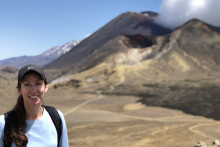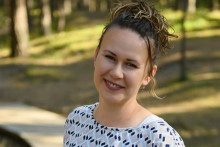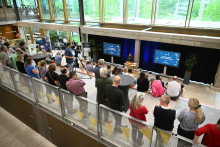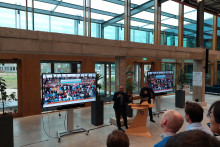Is the recent volcanic eruption in Iceland unique in any way?
Handley: ‘Iceland is very volcanically active. The whole island is essentially one big volcano, and so eruptions are not uncommon. In the area of the current eruption, there is a number of volcanic systems that have been historically active. From that perspective, the eruption is not a big surprise. However, the particular location was surprising. The eruption impacted the local settlement, while there is no recorded history of volcanic activity directly in or near the town. It is estimated that the last eruption in Grindavik area happened thousands of years ago.’
As an experienced volcanologist, does this eruption worry you?
‘This was the fifth eruption in the area in less than three years. That raises the big question: does this mark the start of reactivation of this volcanic system and if so, how long will the activity continue? That is the big unknown.’
Volcanic eruption in Iceland
After the latest volcanic eruption in Iceland on Sunday, lava flowed into the fishing town Grindavik, where it destroyed several houses. The Icelandic Meteorological Office says the situation near Grindavik is improved for now, and that the flow of lava to the town has almost stopped. However, it might be premature to declare the end of eruption, as this was the fifth eruption in less than three years on the Reykjanes peninsula, which had not previously seen one in centuries. Therefore, there is a continued likelihood that new eruption fissures may open without warning.
Is it possible to predict and prepare for such a volcanic eruption?
‘Iceland has a lot of experience in monitoring volcanic activity, and they try to mitigate the risks. Through close monitoring they anticipated this eruption and had been building protective walls to divert the flowing lava away from the town. Unfortunately, they can’t control exactly where the lava will break out at the surface. This eruption was what we call a fissure eruption. To picture it, imagine a long crack in the earth’s surface. Lava can then come up anywhere in this long crack.’

To illustrate, another volcano on the Reykjanes peninsula that recently erupted.
What type of research and technology helps us predict an eruption?
‘Current science allows us to monitor and try to predict if a volcanic eruption is likely. We can use ground observations, but we can also apply satellite data – the expertise of ITC. Based on satellite imagery, we can track thermal anomalies, gas emissions, and observe ground movements. Before an eruption, the land surface often inflates, so to speak. There was a ground movement of 1.4 meters before the current eruption. It’s also possible to track the movement of lava underground.
'Having an understanding of past behavior of volcanically active areas is vital, but there is always a level of uncertainty'
In my research, I study past volcanic eruptions and volcanic rocks to better understand the timescale of eruptions – and to determine warning times. We can analyze the rock samples to see how often, how fast, and how intensely the volcano has erupted in the past – and how it has impacted people and the surrounding environment. Based on that we can adapt and better prepare for the future.
Having an understanding of past behavior of volcanically active areas is vital, but there is always a level of uncertainty. The timing and exact location of a potential eruption remains unclear. The Icelandic volcanologists and authorities evacuated Grindavik because they could track the movement of magma underground and feared the town might be impacted, not because they were absolutely certain of it.’
Volcanologist Heather Handley
Heather Handley is an experienced volcanologist, who has worked on some of the most active volcanoes on the planet. Handley, now an Associate Professor of volcanic hazards and geoscience communication at the ITC Faculty of the University of Twente, studies chemistry of volcanic rocks and their minerals to better understand how volcanoes work and what triggers volcanic eruptions in order to reduce volcanic risk.
Are we able to foresee how the eruption will develop? The volcanic activity is easing now, but are more eruptions likely to occur?
‘The activity has subsided for the moment but it’s impossible to tell if there won’t be another – and how intense it might be. That is a constant worry. We can’t predict when the eruptive phase will end. Moreover, even if the lava doesn’t cover the town, it has impacted the ground and made the town unsafe.’
Does the eruption pose any potential danger to the rest of Europe and the world?
‘Not with the present setting. With these types of eruptions, the main hazards are the oozing lava and dangerous volcanic gases, which lead to air pollution. There was a worry that the gas pollution might reach the city of Reykjavik, but that has not been a worry at present due to the current wind direction. Right now, it looks like the impacts will be localised. A potential risk is the lava moving towards the coast and coming in contact with sea water. In that case, the reaction could be more explosive and lead to more ash and dangerous gas.’
'I worry about the next large-scale eruption, meaning one that will have a global impact. We are not prepared for such a global volcanic risk'
In general, what type of volcanic activity should people be aware of, and why? What are the main volcanic hazards and risks?
‘From my point of view, I worry about the next large-scale eruption, meaning one that will have a global impact. Just think of the Covid-19 pandemic. It was only a hundred years since the last pandemic; various experts warned us that it might happen and we believed them, yet we were completely unprepared for it. I foresee the same for the next large volcanic eruption.
The 1815 Tambora eruption in Indonesia was the largest observed eruption in recorded history, and it had a huge impact. If the same happened now, it’d likely have an even bigger impact because it would affect transport, shipping, farming, food security, possibly even GPS systems. However, we are not prepared for such a global volcanic risk. There are no protocols in place. In fact, a new research colleague will join me at ITC soon to study this topic within the ITC’s Centre for Disaster Resilience. We want to see how to set up a global operation and communication system, so that we can coordinate a response to a global volcanic emergency. Such large eruptions happen on average every 400 years. It will happen, it’s just a matter of when – and how we respond to it.’








